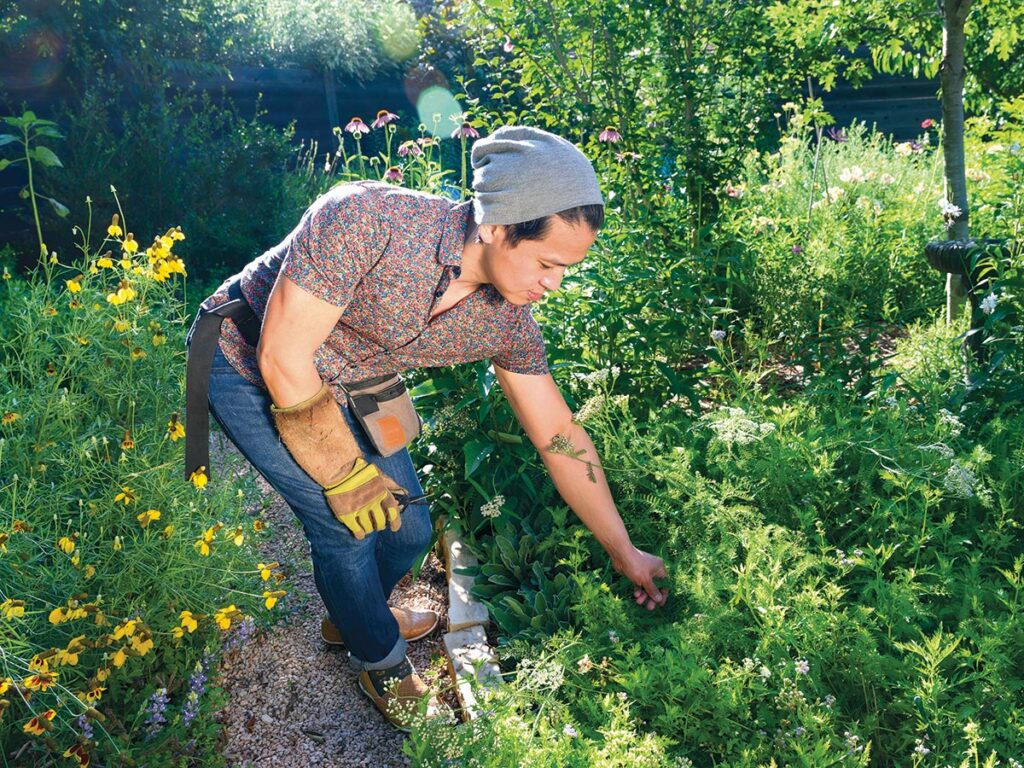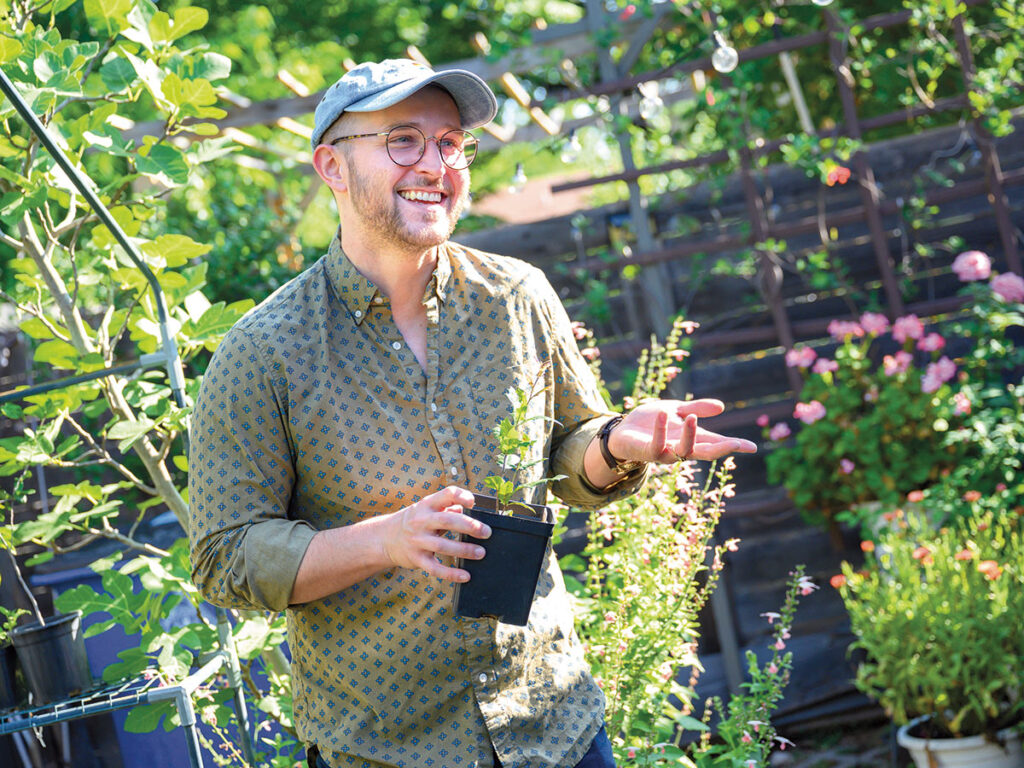Diversity in Nature
Driving through Austin’s historic, diverse east side neighborhood, I scanned the houses on the left and right. I spotted the house I was looking for right away. With a dark blue exterior and a front garden in full bloom, it was like nothing else on the block. There were towering standing cypress (Ipomopsis rubra), lanceleaf coreopsis (Coreopsis lanceolata), spires of mealy blue sage (Salvia farinacea) and other plants native to Texas that shone in the early evening light. I knew I was at the right house before I looked at the address.
Andrew Ong and Jared Goza, also known as Gays Who Garden on Instagram, walked me around their front and back garden, sharing their space with me. The garden graciously wraps around the house, boasting its bright colors and sweet scents.
How did you come up with the concept for Gays Who Garden?
Andrew Ong: We started our Instagram account, Gays Who Garden, when we moved into our new house about four years ago. At the time, there weren’t many similar accounts that we had come across. We wanted to connect with others and increase visibility for people like us who had a strong passion for plants and nature. The name, Gays Who Garden, came to us because it instantly shows our identities and what we wanted to showcase.
Jared Goza: Andrew was taking so many photos of his roses (Rosa spp.), so I suggested that he should start an Instagram account. We started the account together and we have really seen it take off. Initially, we focused on close-up shots of flowers, but recently Andrew has been creating reels and other types of content as well.
How did you initially approach the design of your garden spaces?
JG: When we first started, our approach was to discuss the plants we liked and find suitable spots for them in the garden. We had a blank canvas, as our property had a lot of concrete and very few trees. So, our first major project was removing all that cement and creating space for plants. Once we cleared the space, we focused on planting trees like oaks (Quercus spp.), magnolias (Magnolia spp.), and redbuds (Cercis spp.). The only existing tree was a pecan tree (Carya illinoinensis), which was unfortunately planted right above the gas line. It killed me to think we’d have to take out the tree, but it would literally kill us if we didn’t. It’s important to avoid having to move trees, as we’ve had to do that a few times.
AO: If we could start this all over, we would first get our soil tested. We are fortunate to have good farm soil. We would also plan the garden around the existing bigger trees because trees can change the landscape over time due to variations in light levels.
JG: We consider factors like light, water, and soil when planning the garden. Hydro zoning, which involves grouping plants with similar water needs together, would also be part of our garden design to promote water efficiency. We also focus on incorporating different textures, fragrances, and colors to create a sensory experience in the garden. We draw inspiration from English gardening and have been influenced by visits to places like Kew Gardens in London. That’s where we had our wedding!
AO: It’s important to start small and find your passion first. There are many times where you’ll think to yourself “burn it down to the ground,” or get frustrated and think, I don’t want to do this anymore. Find that one thing that pulls you back into the garden. For me, it’s the roses and ornamentals.
 Andrew meticulously examines the garden, looking for weeds to pull and cultivating different textures, fragrances and colors. PHOTO Ann Alva Wieding
Andrew meticulously examines the garden, looking for weeds to pull and cultivating different textures, fragrances and colors. PHOTO Ann Alva Wieding
Do you prefer to buy your plants, grow them from seed, or a mix of both?
JG: Growing plants from seed has been a significant change in our gardening approach. For us, our rule is, if a plant will take more than a year to reach adulthood, it’s better to buy it. However, almost everything else can be grown from seed, and it’s a cost-effective and rewarding way to fill in the garden.
AO: Our front yard, specifically the wildflower area, was a project where we grew everything from seed over a period of two months during winter. Timing is crucial in Texas gardening, and it’s something that many people may not initially realize. Understanding when to plant certain seeds or start certain plants is essential for success. For example, a common misconception is with bluebonnets (Lupinus texensis). We’ve seen some local stores sell bluebonnet seeds in spring when people see the plants blooming. But by that time, it’s already too late to plant the seeds for that year — those seeds need to be sown in the fall.
Tell me more about the feedback you’ve gotten — both online and from neighbors.
JG: We’ve gotten a lot of great feedback from neighbors! A lot of people say they’re looking for inspiration to create something similar in their own gardens. We often emphasize that our front yard, with its abundance of flowers, is a result of consistent planting and maintenance. We encourage them to start small and gradually increase the number of plants they have. We also mention the importance of watering and understanding the specific needs of different plants.
AO: Everyone has their own vision and goals for their garden, so we try to offer advice that’s just based on our experiences. We want to encourage others to enjoy gardening and find their own unique style and approach.
JG: We did, one time, get a note from the city because one of our plants extended over the sidewalk. As our garden becomes more prominent, it reminded us that there’s increased visibility and scrutiny. We understand and accept that as part of the responsibility that comes with having a vibrant and visible garden. Native grasses like big muhly (Muhlenbergia lindheimeri) tend to grow tall and some people find them unwieldy.
AO: It’s rewarding to see how our garden sparks curiosity and interest in gardening among our neighbors and visitors. The only negative thing I distinctly remember was this one hate message that included, “Why are y’all doing this? Why isn’t it ‘couples who garden?’” Well, this is how we identify. If you don’t like it, I’m sorry you don’t like it. Feel free to move on. No one’s forcing you to follow us. No one’s forcing you to look at our content. We’re not shoving us in your face. We’re just existing and gardening. But most direct messages are more positive, and we get a lot of questions about our process.
JG: We’re always happy to answer questions and share our experiences. One common question we get is where we source our plants, and we always recommend local nurseries and plant sales.
AO: It’s through these connections and the sharing of knowledge that we can all grow as gardeners and individuals. It’s worth all the hard work and challenges.

Goza enjoys growing plants from seed and refines his techniques over time. “We’re always happy to answer questions and share our experiences,” he says. PHOTO Ann Alva Wieding
Do you see gardening as a reflection of your personalities and identities?
JG: Absolutely. Andrew is more left-brained and I’m more right-brained — I want the plants to flourish on their own, allowing them to be independent and grow into their natural beauty. I embrace the wildness and lushness of the garden. Andrew, on the other hand, has a more structured approach. He focuses on organization and creating a sense of order. Our gardening styles mirror how we work and complement each other.
AO: I think of gardeners as helpers and nurturers in the community. We invest in our garden, knowing that we’ll receive something valuable in return. Gardening has taught us resilience and the ability to bounce back from setbacks — which happens often with plants. It reflects our upbringing and the values of sacrifice and taking care of loved ones. Gardening also provides structure and routine, which benefits our mental health. It’s a reflection of who we are as individuals and our nurturing nature.
Jared & Andrew’s Tips for Texas Gardeners
Get your soil tested. Resources include the Texas A&M AgriLife Extension Service for your county.
Start small. Find one area or one type of plant to specialize in where you can make a big impact.
Moving into a new home? Try to let the land rest and see what comes up on its own — plants that were cut back but not fully removed by previous owners may be dormant.
Visit local garden centers and demonstration gardens like the Lady Bird Johnson Wildflower Center for inspiration and to observe what does well in your climate.
